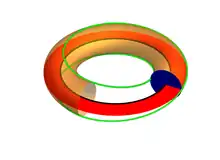Flux surface
In magnetic confinement fusion, a flux surface is a surface on which magnetic field lines lie. Since the magnetic field is divergence-free (and magnetic nulls are undesirable), the Poincare-Hopf theorem implies that such a surface must be either a torus, or a knot. In the tokamak and the stellarator flux surfaces have toroidal shapes, whereas the more exotic knotatron[1] has a knotted flux surface. Flux surfaces are typically characterized the poloidal magnetic flux or the toroidal magnetic flux. The poloidal flux is the magnetic flux passing through a ribbon going from the magnetic axis (the centre of the device) to the flux surface, and the toroidal flux is the magnetic flux passing through a circle which encloses the magnetic axis. The total flux passing through flux surface itself is zero, as magnetic field lines are everywhere tangent to the surface.

Flux surfaces can either be rational or irrational, depending on the behavior of magnetic field lines on the flux surface. Rational surfaces have magnetic field lines are which are periodic; the magnetic field line closes back on itself. Conversely irrational surfaces have magnetic field lines which do not close back on themselves, and a magnetic field line traces out the entire flux surface (the magnetic field line comes arbitrarily close to each point on the flux surface). Rational magnetic surfaces are very sensitive to perturbations and can degenerate into magnetic islands.[2][3] Flux surfaces are not guaranteed to exist; the magnetic field line can fill a volume chaotically.[4] The theory of magnetic field lines in toroidal systems is closely related to the theory of 2-dimensional Hamiltonian systems.[5]
References
- Hudson, S. R.; Startsev, E.; Feibush, E. (January 2014). "A new class of magnetic confinement device in the shape of a knot". Physics of Plasmas. 21 (1): 010705. Bibcode:2014PhPl...21a0705H. doi:10.1063/1.4863844. ISSN 1070-664X.
- Hegna, Chris C.; Bhattacharjee, A. (February 1989). "Magnetic island formation in three‐dimensional plasma equilibria". Physics of Fluids B: Plasma Physics. 1 (2): 392–397. Bibcode:1989PhFlB...1..392H. doi:10.1063/1.859152. ISSN 0899-8221.
- Smolyakov, A. I.; Hirose, A.; Lazzaro, E.; Re, G. B.; Callen, J. D. (May 1995). "Rotating nonlinear magnetic islands in a tokamak plasma". Physics of Plasmas. 2 (5): 1581–1598. Bibcode:1995PhPl....2.1581S. doi:10.1063/1.871308. ISSN 1070-664X.
- Sugimoto, H; Kurasawa, T; Ashida, H (March 1, 1994). "Stochastic diffusion of magnetic field lines". Plasma Physics and Controlled Fusion. 36 (3): 383–402. Bibcode:1994PPCF...36..383S. doi:10.1088/0741-3335/36/3/002. ISSN 0741-3335. S2CID 250897544.
- Morrison, P. J. (June 2000). "Magnetic field lines, Hamiltonian dynamics, and nontwist systems". Physics of Plasmas. 7 (6): 2279–2289. Bibcode:2000PhPl....7.2279M. doi:10.1063/1.874062. ISSN 1070-664X.